|
 Crepidotus nanicus Crepidotus nanicus
SynonymsCrepidotus nanuus
BiostatusPresent in region - Indigenous. Endemic
Images (click to enlarge)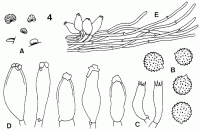
Caption: Crepidotus nanicus Horak (type): A. carpophores. — B. spores. — C. basidia. — D. cheilocystidia. — E. cuticle | 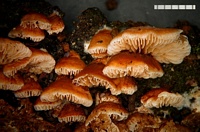
Owner: J.A. Cooper | 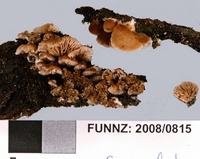
Owner: J.A. Cooper | 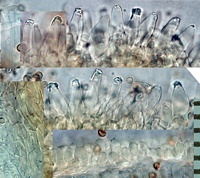
Caption: left: clamped hypha and cap tissue. Right: cheilocystidia.
Owner: J.A. Cooper | 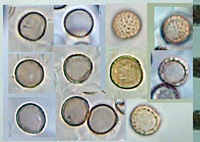
Owner: J.A. Cooper | 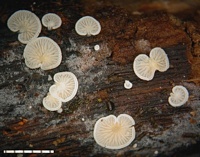
Owner: J.A. Cooper | 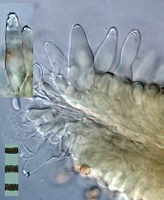
Caption: cheilocystidia
Owner: J.A. Cooper | 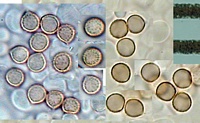
Caption: spores
Owner: J.A. Cooper | |
Article: Horak, E. (1978) [1977]. Crepidotus episphaeria and related species from the Southern Hemisphere. Berichte der Schweizerischen Botanischen Gesellschaft 87: 227-235.
Description: Pileus -7 mm, dimidiate, conchate
or reniform, margin incurved and inconspicuously striate, pale brown to argillaceous
when young becoming reddish brown in aged carpophores, near point of attachment
covered with white velutinous mycelium or white substrigose hairs, smooth towards
margin, dry. Lamellae laterally concurrent, ventricose, crowded, pale argillaceous
turning pale red-brown, edge concolorous, smooth. Stipe absent, carpophores
laterally attached to substratum, single, in dense groups. Odour and taste not
distinctive. Context pale brown, gelatinous stratum absent. Spore print pale
red-brown.
Spores 5-6 µm., subglobose, covered
with hemispherical warts, perispor indistinct, brown. Basidia 20-25/6-7 µm,
4-spored. Cheilocystidia 20-35/8-15 µm, lageniform to subfusoid, hyaline, membrane
up to 1 µm thick near apex, thinning towards base, encrusted with scatterd crystals.
Pleurocystidia absent. Cuticle a cutis or trichoderm of cylindrical hyaline
thin-walled hyphae (2-4 µm diam.), occasionally with clusters of dermatocystidia
(shape like cheilocystidia), membranes of hyphae not gelatinized. Clamp connections
present.
Habitat: On rotten wood of Nothofagus menziesii
(Fagaceae).
|